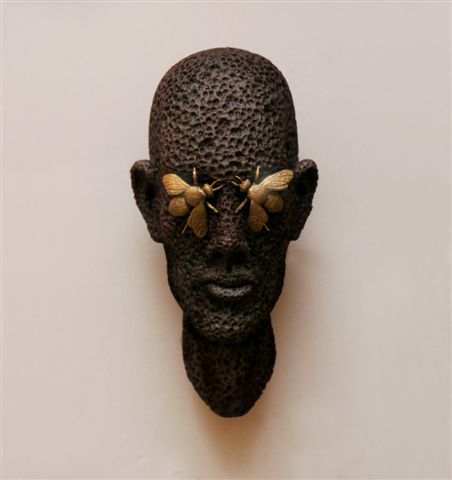
Archeology, fantasy and humor – an infrequent commodity in Israeli art – are brought together in Towards the Surface, a group show featuring the work of ten artists associated with the Rosenfeld Gallery, Tel Aviv. The mood is set at the entrance with Eli Gur Arie‘s blackened and pitted skull, golden beetles resting on empty eye sockets. Like British artist Damien Hirst’s outrageous work – a cast of a human skull encrusted with diamonds – Gur Arie’s skulls seem to be making fun of this weighty Vanitas symbol, popular in 16th and 17th century art, that pointed to the brevity of life and inevitability of death.
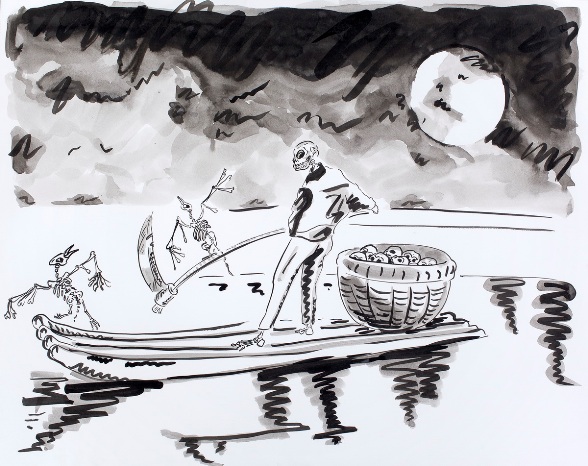
Pearl River, a lighthearted drawing by Shai Zurim sited nearby, depicts a skull-headed figure rowing across an expanse of water. In his boat is a basket of skulls. From its title, one might suppose that Zurim is referring to the Guangdong River in China (has he visited there?). But an allusion to the boatman of Hades ferrying the dead across the Styx seems more probable, mixed in with the Tale of the Ancient Mariner where the boatman is forced to wear a dead Albatross around his neck. Here, instead, Zurim perches a skeletal bird on an oar in the form of scythe.
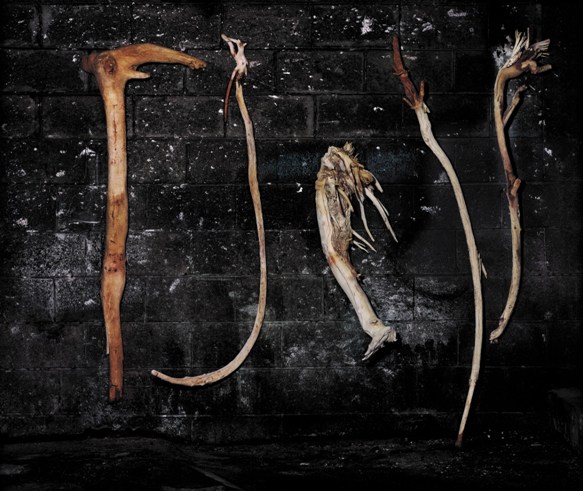
The scarred, frail objects that Amon Yariv photographs against a tarred wall could be viewed as remnants of a place where some catastrophic event has occurred. If this is so, then in spirit and content, Yariv’s photos relate to a set of paintings by Larry Abramson featuring dead branches of trees gathered from the ruins of Tsuba, an Arab village near Jerusalem, abandoned during the War of Independence. In Abrams’ case these fragments of Nature were transposed, trompe d’oeil, onto to his canvas to read Shalom, Shalom, – words emptied of meaning. Yariv’s configuration of wood and rope could similarly be interpreted as letters from an alphabet whose meaning is no longer known or acceptable.
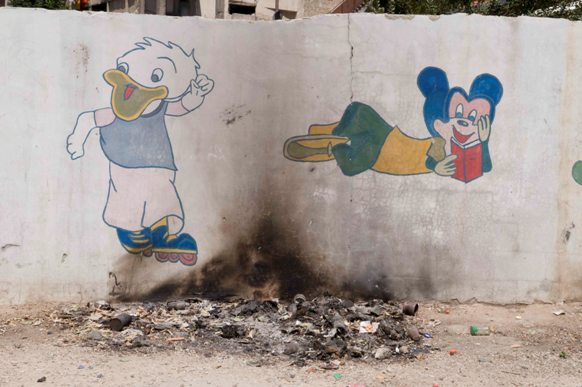
Remnants – a pile of burnt refuse – are also seen in Boaz Arad‘s photos taken in Sheikh Jarrah, a Palestinian neighborhood of East Jerusalem. Above is a smoke stained, crumbling wall, with a line of houses just visible behind. Painted onto this surface are two happy-go-lucky Disney characters, oblivious of the fact that graffiti of quite a different kind is regularly used by local residents and international activists as a tool for protest and resistance.
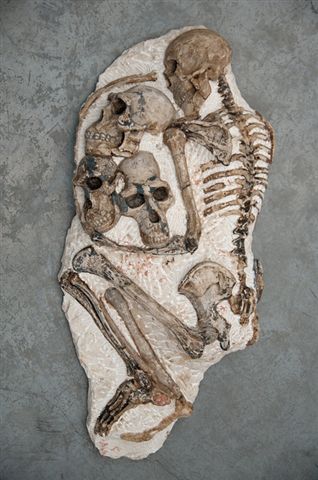
A delicate ink drawing of a mummy by Rachel Kainy, like an ink blot that has coalesced into a recognizable shape, gives way to Zohar Gottesman‘s limestone sculpture where a skeleton in a fetal position, three skulls resting in the crook of its arm, has been carved into the mass of the stone. The artist, who has spent time in Italy, in Carrara, learning sculpting techniques, has used tea and coffee to stain this intriguing piece.

Tamir Zadok‘s Iben Yunes Mosaic is the centerpiece of this show. It is in the form of a half-completed “ancient” artifact depicting a group of five bare breasted women; a scene that (according to Zadok) inspired Picasso’s famous painting Les Demoiselles d’Avignon. Alongside this mosaic is a pseudo-scholarly text outlining the provenance of this piece and its connections to Picasso. This unusual work (both for its content and the fact that few artists in Israel are creating mosaics) has an interesting theme: it questions the accuracy of artistic sources that are taken for granted. But also, the fact that the identity of nations is partially based on the evidence of archeological remnants whose authenticity is rarely in doubt.
This is an attractive show, but it suffers from the fact that most artists are represented by only one work, often taken from a series. So the full effect and meaning is lost. This is particularly true as regards Tal Shochat‘s fine photo of dead branches transposed to an indoor setting, which was part of a 2005 series featuring decaying trees in an Israeli orchard.
Also participating in this show, open till Nov. 24, are Ra’anan Harlap, Marik Lechner and Roee Rosen
Rosenfeld Gallery, 1 Shvil Hamifal St., Tel Aviv. Tel: 03.5229044





